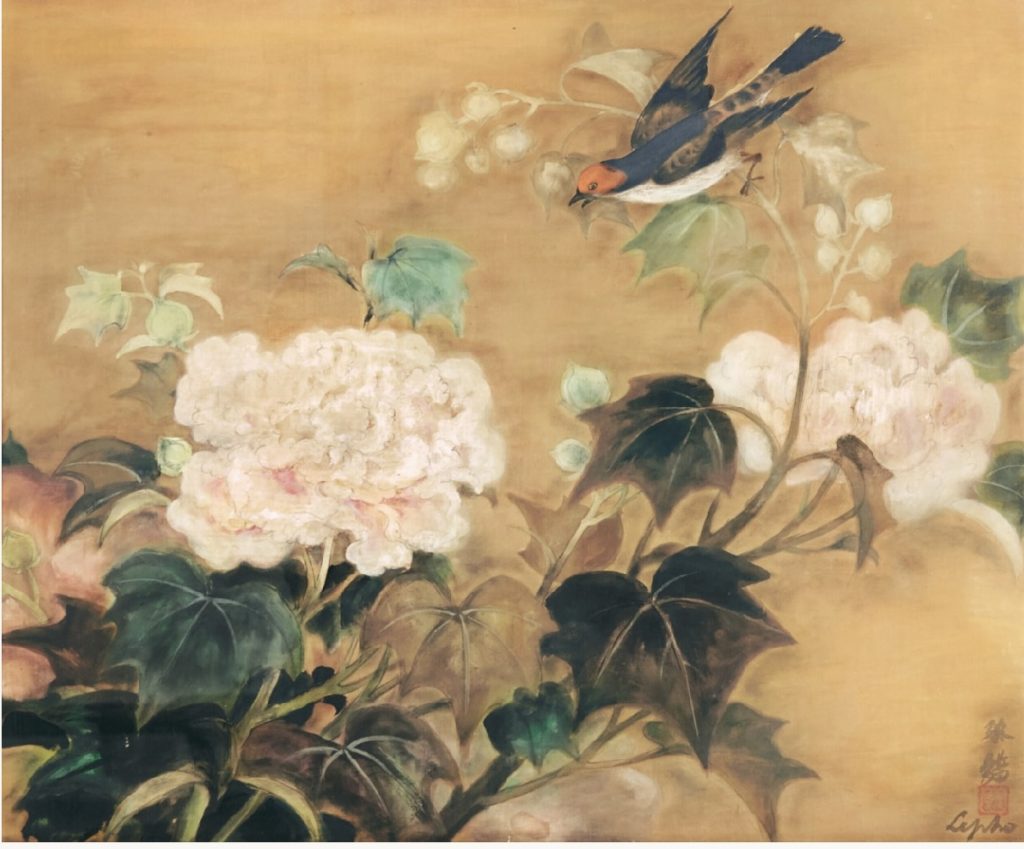Le Pho, « The Peonies and The Bird », circa 1936, or the leap to freedom
This Le Pho’s work is not only unique by its subject, its style and its date, but is also of an exceptional quality in his oeuvre.
The painter usually favored the representation of women, children, flowers, some landscapes, religious scenes, still lives, including, only once – subject to inventory – fish, he rarely painted birds. We can cite, in particular, two later works, one depicting two turtledoves, posed on a bamboo fence, dated 1937 illustrated (unpaginated) in Waldemar George Le-Pho, Paris 1970, “La Femme au Perroquet” painted around 1938 and a few others.

Le Pho has never claimed to be a realist painter. Nature, while not showing any malice, is only inspiring to him when he isolates it in his service. A great lover of flowers, he wanted to capture them in the moment, in their gesture. Nothing lasts for a painter, even less for Le Pho. All the beauty is in the brevity that he will seize as a conqueror.
The peony has it all: queen of flowers – certainly after the lotus -, “evening beauty” of the ancient Chinese poets, symbol of the beloved woman and of feminine beauty and prosperity in general.
Massive, surrounded by darker leaves they occupy the space. The painter guides us from left to right and upward to the bird emerging from the dense dark green leaves and stems in a wash. The bird, a Chim sâu đầu đỏ, a scarlet-headed dicta, endemic to Sulawesi but found in Vietnam, is appreciated for its singing.
Is this bird landing or flying away? It is Le Pho himself at a time in his life when the call for the West is pressing.
If the painter’s three periods (early, Romanet, Findlay) are easily identifiable in their broad outlines, proposing a precise date of execution postulates a great deal of subtlety. The artist himself did not date many of his works, he did not record many of them, he lived his time without counting, and the lists of exhibitions with similar titles can lead to confusion. Moreover, and I will allow myself a personal anecdote here, the painter himself hesitated about some of his dates: for hours and hours at home with him and Paulette, his wife, in their luminous apartment in the rue de Vaugirard in Paris, we discussed the subject. Epic activity. Including when he calmly “specified” the dates of Waldemar George’s book. The debate is perpetual in art. And authorizes inflections. Paulette always got out of it by affirming with the elegant smile that characterized her: “Don’t ask me any questions prior to 1945, I don’t know anything about it”, 1945 being the date of their meeting…
Nevertheless, several elements carefully taken into account, such as the background no longer left uncovered as in the early 30s, but covered with a brown wash, as in “Les Lys“, the pastel tone of the pigments, the medium-sized stamp, the style of the calligraphic signature in Romanized letters, postulate a dating around 1936. A painting dated in the artist’s hand 1942 and executed in France shows the later evolution: Le Pho subtly modifies his style by painting a more cross-hatched background, lotuses and a more luminous general atmosphere, and uses a rather simple signature in romanized letters, without stamp or Chinese characters.
“Peonies and the Bird” remains impregnated with the painter’s stay in Beijing in 1934 where he visited the National Museum and the Palace Museum but also some private collections and rubbed shoulders with the real ancient Chinese paintings.
The painter offers a bird in greater detail and color than the rest of the representation, which is more stylized. In a floating environment, the bird is in movement, wings spread, legs extended. The scarlet head, the open beak point to the dynamism.
Le Pho refuses the symbol in the symbol: he paints a realistic bird, of the kind we like to watch and listen to while trying to delay their departure that we know inexorable. The observer will say that the bird has escaped, the artist understands, messianic, that the flight is liberation… The peonies will wither, the bird will take flight and only the work of art will remain.
No one can be deprived of his nostalgia but freedom is the absolute quest of the earthly existence
The wings spread and the flight begins. The two beautiful peonies and their 15 promising buds will not hold him back.
Le Pho already knows that when he paints his picture, he will fly to the West where his destiny awaits him, the destiny of an artist in search of eternity.
Jean-François Hubert